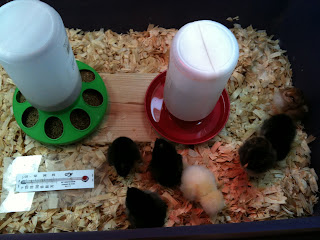
What's a Heritage Breed? Well, it's defined by the American Livestock Breed Conservancy (ALBC) and is basically this:
1) It comes from American Poultry Association (APA) stock from prior to the mid 20th century
2) Maintained through natural mating.
3) Long, productive outdoor lifespan.
4) Slow growth rate. This gives time for bone and organ development before muscle mass.
 Why a Heritage Breed? Not genetically engineered. Better foraging skills and longer egg laying life make these birds are perfect for homesteaders looking to reduce feed inputs. Buying these breeds keep the breeders producing them, which keeps them from becoming extinct.
Why a Heritage Breed? Not genetically engineered. Better foraging skills and longer egg laying life make these birds are perfect for homesteaders looking to reduce feed inputs. Buying these breeds keep the breeders producing them, which keeps them from becoming extinct.We had a rubbermaid container setup as our brooder with a heat lamp, pine shavings, feeder and waterer. When you first put the chicks in the brooder, you dip their beak in the water, so they know were to find it. After they got warmed up, they took a brief nap from the long trip, then started eating, drinking and running around. We weighed all the chicks, which ranged from 27-40grams. As a project for the kids, we are going to try to weigh them every day to show how fast they grow.
The yellow chick is the Delaware, but will grow into a mostly white bird. She's a heritage breed and has a status of "threatened" (APA since 1962). It achieved the Slow Food RAFT and Ark of Taste recognition. It's rated as a dual purpose breed (good for meat and eggs, but generally not "great" at either), "good" layer of large, brown eggs, docile temperament, does well in hot and humid or cold climate, does well confined with other chickens, natural forager, but can go broody (wants to hatch eggs). Broody isn't bad, if you want to hatch eggs. We don't have a rooster yet, but this would make a natural mother when we get one.
The brown chick is the Welsummer. She's from the Netherlands, and is thus, not a heritage breed. She's also a dual purpose breed, good layer of large, brown eggs, docile temperament, does well in colder climates, free range, and is a natural forager.
The black and brown chick is a Golden Laced Wyandotte. We have a Silver Laced Wyandotte, but we couldn't pass up the Golden variety. She's a Heritage Breed and listed as "recovering", so she's making a comeback. APA since 1883. She's also a dual purpose breed, good layer of large brown eggs, docile, does well confined with other chickens, and happy with free range.
We have four more black chicks that will have to grow more to determine which is which, but I think I have it figured out.
The Australorp is the black chick with a yellow spot in front and behind the eye and has a black beak with a
 The Black Jersey Giant is the black chick with yellow spots under the eyes with black beak. It's the largest
The Black Jersey Giant is the black chick with yellow spots under the eyes with black beak. It's the largest The Silver Cuckoo Marans is the black chick with a white mohawk shaped spot, no facial markings, sawtoothed
comb, and a white beak with black tip. It's not a Heritage Breed, but is known for deep chocolate or coppery
temperament, does well in hot and humid or cold climates, does well in confinement or free range, and can go
broody.






